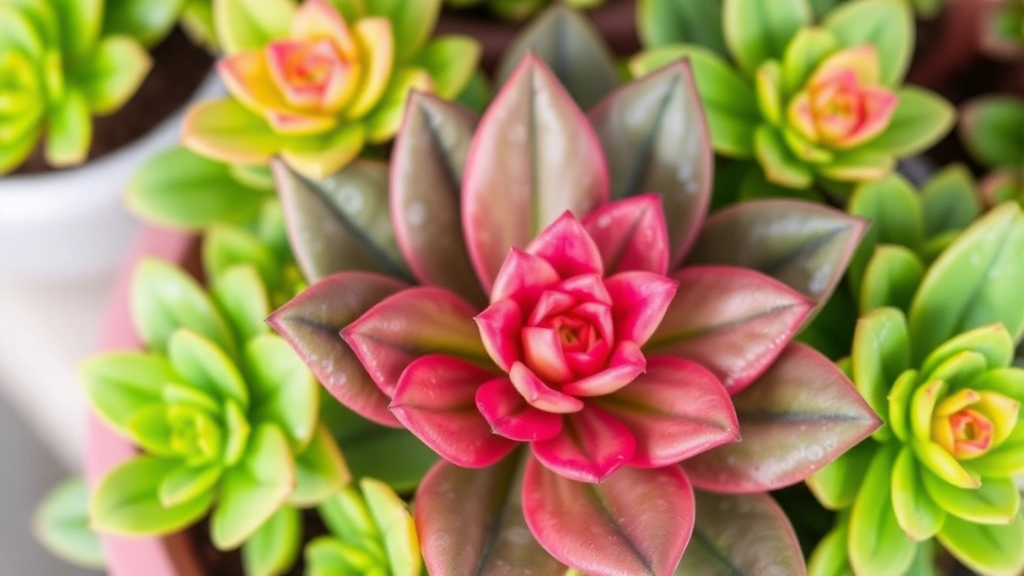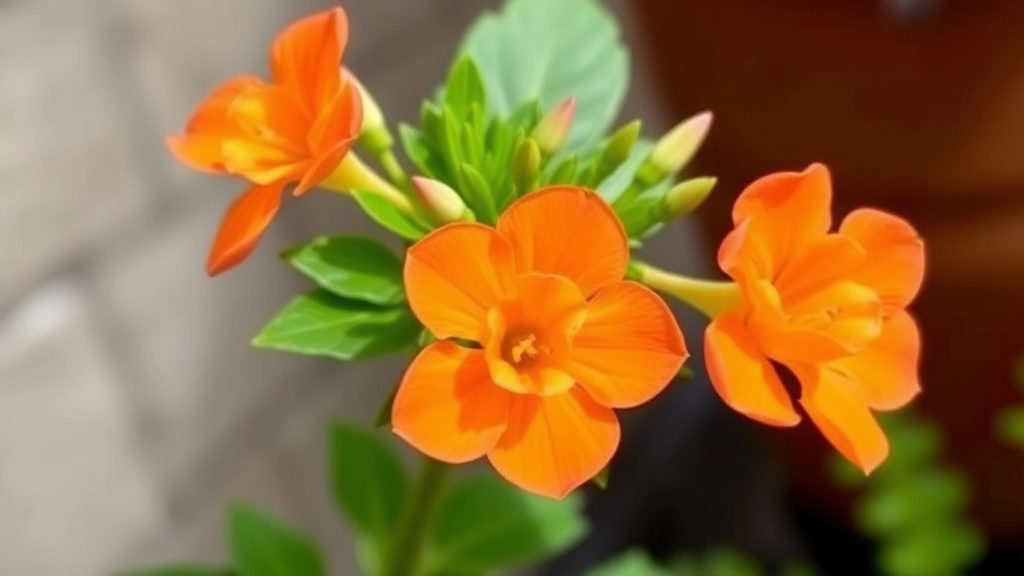Caring for Kalanchoe Orange Bells
Ever wondered how to keep your Kalanchoe Orange Bells thriving? This vibrant succulent, known for its stunning orange bell-shaped flowers, can be a delightful addition to your home garden. Let’s dive into the essentials of caring for these beauties, from ideal light and temperature conditions to watering and soil care. Whether you’re new to gardening or a seasoned green thumb, these tips will help you maintain the health and vibrancy of your Kalanchoe Orange Bells.
Understanding Their Needs
When it comes to growing Kalanchoe Orange Bells, understanding their specific needs is crucial. These plants thrive in bright, indirect light and prefer well-draining soil to prevent root rot. Watering should be done sparingly, allowing the soil to dry out between waterings. Additionally, maintaining a moderate temperature and humidity level will ensure your Kalanchoe Orange Bells bloom beautifully.
Common Problems and Propagation Techniques
Stay tuned as we explore common problems and effective propagation techniques to keep your plants flourishing year-round.
Types and Varieties of Kalanchoe with Orange Flowers
When it comes to Kalanchoe, many plant enthusiasts often find themselves drawn to the vibrant orange flowers that brighten up any space.
Popular Varieties of Kalanchoe with Orange Flowers
- Kalanchoe Blossfeldiana
This variety is known for its stunning clusters of orange blooms.
It typically blooms in cycles, offering a burst of colour multiple times a year. - Kalanchoe ‘Calandiva’
A hybrid known for its double flowers, ‘Calandiva’ showcases rich orange petals.
It has a bushy growth habit, making it a lovely choice for container gardening. - Kalanchoe luciae (Paddle Plant)
While primarily known for its striking leaves, it can produce orange flowers under the right conditions.
This variety is often appreciated for its unique shape and vibrant foliage. For more details, check out the Optimal Care Guide for Kalanchoe Paddle Plant. - Kalanchoe tomentosa (Panda Plant)
Though not as common for orange blooms, with proper care, it can surprise you with its flowers.
Its fuzzy leaves add a touch of texture to any collection. Learn how to keep it thriving from our Kalanchoe Panda Plant Care Guide.
Why Choose Kalanchoe with Orange Flowers?
Kalanchoe plants are not only visually appealing but also relatively easy to care for. Their resilience makes them perfect for both beginners and seasoned gardeners.
Ideal Growing Conditions: Light, Temperature, and Humidity for Kalanchoe

So, you’ve got your eye on a stunning Kalanchoe with those vibrant orange flowers, but how do you keep it thriving?
Light Requirements
First off, let’s chat about light.
Kalanchoe loves bright, indirect sunlight.
- Best Spot: A south-facing window is ideal.
- Too Much Sun: If you notice the leaves getting crispy, it’s a sign it’s getting too much direct sunlight.
- Too Little Light: If your plant starts stretching or becoming leggy, it’s not getting enough light.
Temperature Preferences
Next up, temperature.
Kalanchoe prefers a warm environment.
- Ideal Range: Aim for between 20°C to 25°C (68°F to 77°F) during the day.
- Night Chill: At night, it can drop to around 10°C to 15°C (50°F to 59°F), but don’t let it get colder than that.
- Avoid Drafts: Keep it away from cold drafts or heat sources, like radiators.
Humidity Levels
Now, let’s talk about humidity.
Kalanchoe is pretty adaptable here.
- Low Humidity: It thrives in drier conditions, so no need for a humidifier.
- Indoor Air: Just keep it away from overly humid spots, like bathrooms.
When it comes to caring for your Kalanchoe Orange Bells, understanding the right watering and soil conditions is crucial. Many enthusiasts worry about overwatering or underwatering their plants, leading to stress and poor growth.
### Watering Tips:
– **Frequency**: Water your Kalanchoe when the top inch of soil feels dry. This typically means watering every 2-3 weeks, depending on your environment.
– **Method**: Use the soak-and-dry method. Water thoroughly until it drains from the bottom, then allow the soil to dry out completely before the next watering.
– **Signs of Overwatering**: Yellowing leaves or mushy stems indicate too much water. Adjust your watering schedule accordingly.
– **Signs of Underwatering**: If the leaves begin to shrivel or drop, it’s time to give your plant a drink.
### Soil Care:
– **Soil Type**: Use a well-draining soil mix, ideally a cactus or succulent mix. This helps prevent root rot.
– **pH Level**: Kalanchoe prefers slightly acidic to neutral soil (pH 6.0 to 7.0).
– **Repotting**: Consider repotting every 2-3 years to refresh the soil and provide more space for growth.
### Additional Considerations:
– **Fertilisation**: During the growing season (spring and summer), feed your Kalanchoe with a balanced liquid fertiliser every 4-6 weeks.
– **Drainage**: Ensure your pot has drainage holes to allow excess water to escape.
For more detailed information on caring for similar Kalanchoe varieties, you might find our [complete guide to caring for Kalanchoe Silver Spoons](https://planthq.org/complete-guide-to-caring-for-kalanchoe-silver-spoons/) helpful. Additionally, if you’re looking to explore other types of Kalanchoe, check out our [top Kalanchoe succulent varieties and care tips](https://planthq.org/top-kalanchoe-succulent-varieties-and-care-tips/).
Common Problems and How to Solve Them (Root Rot, Overwatering, etc.)

As we explore the care of Kalanchoe with orange flowers, it’s essential to address common issues that may arise during their growth.
Root Rot
One of the most frequent problems faced by Kalanchoe enthusiasts is root rot. This condition occurs when the roots sit in waterlogged soil, leading to decay.
- Signs of Root Rot:
- Yellowing leaves
- Wilting despite adequate watering
- Foul smell from the soil
Solution:
- Immediate Action: Remove the plant from its pot and inspect the roots. Trim away any black, mushy roots.
- Repotting: Use fresh, well-draining soil and a pot with drainage holes.
- Watering Schedule: Allow the soil to dry out between watering sessions.
Overwatering
Overwatering is another common issue that can lead to the decline of your Kalanchoe. While these plants enjoy moisture, they thrive best in slightly dry conditions.
- Signs of Overwatering:
- Droopy leaves
- Wilting
- Mold on the soil surface
Solution:
- Adjust Watering: Water less frequently, ensuring the top inch of soil dries out before the next watering.
- Soil Check: Consider using a soil moisture meter to gauge when your plant truly needs water.
Pest Infestations
Kalanchoe can also fall prey to pests like aphids and mealybugs, which can sap their vitality.
- Signs of Infestation:
- Sticky residue on leaves
- Visible pests
- Leaf discoloration
Solution:
- Manual Removal: Wipe affected areas with a damp cloth.
- Insecticidal Soap: Apply insecticidal soap or neem oil for more severe infestations.
Propagation Techniques: Stem Cuttings and Leaf Cuttings
Are you looking to expand your collection of Kalanchoe with orange flowers? Propagation is an excellent way to do just that.
Stem Cuttings
One of the most effective methods is through stem cuttings. Here’s how to do it:
- Select a Healthy Stem: Choose a healthy stem that is at least 4-6 inches long. Ensure it has a few leaves attached.
- Make the Cut: Use a clean, sharp knife or scissors to cut just below a node. This is where new roots will form.
- Let It Callous: Place the cutting in a dry, warm area for a few hours or overnight. This allows the cut end to callous over, reducing the risk of rot.
- Planting: After callousing, plant the cutting in a well-draining soil mix. A cactus or succulent mix works best.
- Water Sparingly: Water lightly after planting. Keep the soil slightly moist but not soggy.
- Provide Light: Place the pot in a bright location but avoid direct sunlight until roots establish.
Leaf Cuttings
If you prefer a more straightforward method, leaf cuttings can also be effective. Here’s how to propagate using leaves:
- Choose a Leaf: Select a healthy leaf from the parent plant.
- Cut the Leaf: Using a clean tool, cut the leaf into sections, ensuring each piece is at least 2-3 inches long.
- Let It Callous: Similar to stem cuttings, allow the cut edges to dry and callous for a few hours.
- Plant the Sections: Lay the leaf cuttings flat on the soil surface or bury them slightly, depending on the type of leaf.
- Water and Light: Water lightly and place in a bright spot, avoiding direct sunlight.
Both methods can yield successful results, but patience is key. For more detailed information, check out our expert tips on Kalanchoe Chocolate Soldier care and our comprehensive guide to Kalanchoe plant care.
FAQs about Kalanchoe Orange Bells
What are the ideal light conditions for Kalanchoe Orange Bells?
Kalanchoe Orange Bells thrive in bright, indirect sunlight. A south-facing window is ideal. Be cautious of too much direct sunlight as it can make the leaves crispy. If the plant becomes leggy, it may need more light.
What temperature range is best for Kalanchoe Orange Bells?
The ideal temperature range during the day is between 20°C to 25°C (68°F to 77°F). At night, it can drop to around 10°C to 15°C (50°F to 59°F). Avoid exposing the plant to cold drafts or heat sources.
How much humidity does Kalanchoe Orange Bells need?
Kalanchoe Orange Bells are quite adaptable to humidity levels. They thrive in drier conditions and do not require a humidifier. Avoid placing them in overly humid areas like bathrooms.
What are the signs of root rot in Kalanchoe Orange Bells?
Signs of root rot include yellowing leaves, wilting despite adequate watering, and a foul smell from the soil.
How can I treat root rot in Kalanchoe Orange Bells?
Immediate Action: Remove the plant from its pot and inspect the roots. Trim away any black, mushy roots. Repotting: Use fresh, well-draining soil and a pot with drainage holes. Watering Schedule: Allow the soil to dry out between watering sessions.
What are the signs of overwatering in Kalanchoe Orange Bells?
Signs of overwatering include droopy leaves, wilting, and mold on the soil surface.
How can I prevent overwatering in Kalanchoe Orange Bells?
Adjust Watering: Water less frequently, ensuring the top inch of soil dries out before the next watering. Soil Check: Consider using a soil moisture meter to gauge when your plant truly needs water.
What pests commonly affect Kalanchoe Orange Bells?
Common pests include aphids and mealybugs. Signs of infestation include sticky residue on leaves, visible pests, and leaf discoloration.
How can I treat pest infestations in Kalanchoe Orange Bells?
Manual Removal: Wipe affected areas with a damp cloth. Insecticidal Soap: Apply insecticidal soap or neem oil for more severe infestations.
References
-
Kalanchoe Plant Profile
-
Tips for Growing Kalanchoe
-
Kalanchoe: How to Grow and Care for Kalanchoe Plants
